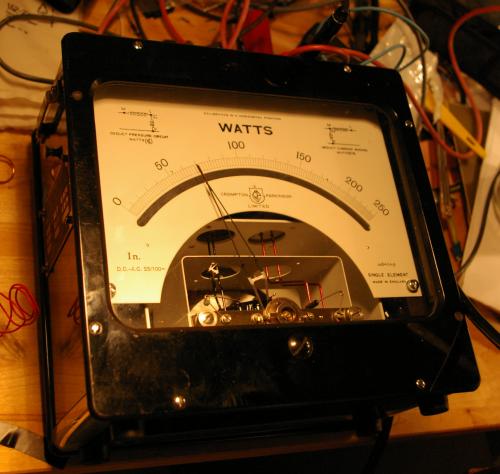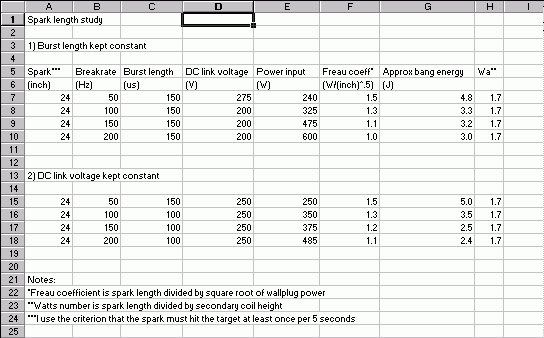


Wattmeter under test. You multiply the reading by 5 when running off 240v
Once I had checked it using a true RMS multimeter and a resistive load, I hooked it up to measure the input power to my DRSSTC. I decided to try generating the same size of spark using various breakrates and burst lengths, and see how efficient each was.

The "lab" ready for experiments
I noted the DC link voltage and wattmeter reading for each breakrate. At higher breakrates, it seemed to strike either not at all, or very frequently. The wattmeter needle kicked up with each strike to the target so I had to "average by eye".
For the next experiment, I used the same four breakrates. This time, I held the DC link voltage constant at 250V, and adjusted the burst length to keep the spark at 24".

Table of results
Here is the MS Excel spreadsheet (Sorry, *nix users! Hope you have OpenOffice :P) |
 |
Short bursts of high peak power seem to grow sparks more efficiently than long bursts of low peak power (but the same energy). It was already known, for instance, that a 150us burst from a DRSSTC would make a more efficient spark than a 10ms one from a plain SSTC, but this is the first demonstration that, say, a 100us burst works better than a 150us one.
The difference between short and long bursts is hardly noticeable at low breakrates. But streamers made from short bursts seem to coalesce (reach their full length) at a higher breakrate. This may explain the "gas burner" effect on spark-gap coils, which have shorter and more powerful bursts compared to DRSSTCs (but see below)
Evidence for the above: See graph 2. The pink trace levels off at 150bps whereas the blue one had already levelled off at 100bps. The point where the graph levels off suggests that coalescence is complete and increasing the breakrate any further won't buy you bigger sparks.
The results don't say anything definite about the corollary: that short high-power bursts are LESS efficient at promoting streamer growth at LOW breakrates. There is a trend in this direction but it is smaller than the experimental errors. So the explanation for the gas burner effect is not very well supported.
These trends are in general agreement with Steve Ward's DRSSTC work: he found that using a lower impedance tank circuit to draw higher peak power from the inverter, and shortening the burst length to maintain the same bang energy as before, gave longer sparks.